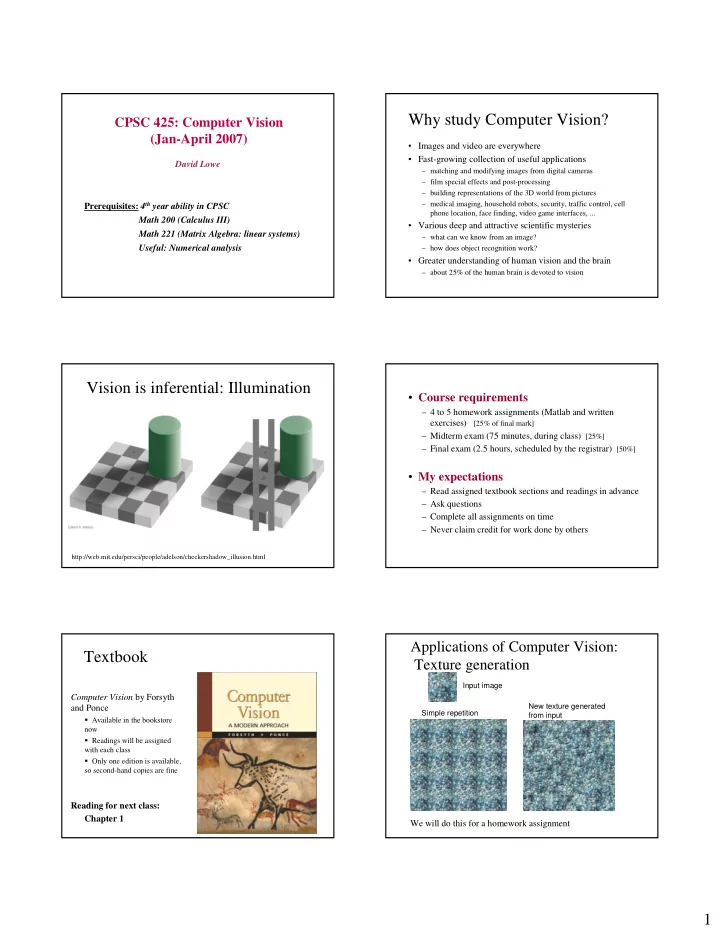

CPSC 425: Computer Vision Why study Computer Vision? (Jan-April 2007) • Images and video are everywhere • Fast-growing collection of useful applications David Lowe – matching and modifying images from digital cameras – film special effects and post-processing – building representations of the 3D world from pictures Prerequisites: 4 th year ability in CPSC – medical imaging, household robots, security, traffic control, cell phone location, face finding, video game interfaces, ... Math 200 (Calculus III) • Various deep and attractive scientific mysteries Math 221 (Matrix Algebra: linear systems) – what can we know from an image? Useful: Numerical analysis – how does object recognition work? • Greater understanding of human vision and the brain – about 25% of the human brain is devoted to vision Vision is inferential: Illumination • Course requirements – 4 to 5 homework assignments (Matlab and written exercises) [25% of final mark] – Midterm exam (75 minutes, during class) [25%] – Final exam (2.5 hours, scheduled by the registrar) [50%] • My expectations – Read assigned textbook sections and readings in advance – Ask questions – Complete all assignments on time – Never claim credit for work done by others http://web.mit.edu/persci/people/adelson/checkershadow_illusion.html Applications of Computer Vision: Textbook Texture generation Input image Computer Vision by Forsyth New texture generated and Ponce Simple repetition from input � Available in the bookstore now � Readings will be assigned with each class � Only one edition is available, so second-hand copies are fine Reading for next class: Chapter 1 Pattern Repeated Pattern Repeated Pattern Repeated We will do this for a homework assignment 1
Application: Football first-down Application: Augmented Reality line Application areas: – Film production (the “match move” problem) – Heads-up display for cars – Tourism – Architecture – Training Technical challenges: – Recognition of scene – Accurate sub-pixel 3-D pose – Real-time, low latency www.sportvision.com Requires (1) accurate camera registration; (2) a model for distinguishing foreground from background Application: Automobile Application: Medical augmented navigation Reality Lane departure warning Pedestrian detection Mobileye (see mobileye.com) • Other applications: intelligent cruise control, lane change assist, collision mitigation Visually guided surgery: recognition and registration • Systems already used in trucks and high-end cars Course Overview Course Overview Part II: Early Vision in One Part I: The Physics of Imaging Image • Representing local properties of the image • How images are formed – For three reasons – Cameras • Sharp changes are important in practice -- find “edges” • What a camera does • We wish to establish correspondence between points in • How to tell where the camera was (pose) different images, so we need to describe the neighborhood of – Light the points • How to measure light • Representing texture by giving some statistics of the different kinds of small patch present in the texture. • What light does at surfaces – Tigers have lots of bars, few spots • How the brightness values we see in cameras are determined – Leopards are the other way 2
Course Overview Course Overview Part III: Vision in Multiple Part IV: High Level Vision Images • The geometry of multiple views • Model based vision – Where could it appear in camera 2 (3, etc.) given it was here in 1? • find the position and orientation of known objects – Stereopsis • Using classifiers and probability to recognize objects – What we know about the world from having 2 eyes – Templates and classifiers • Structure from motion • how to find objects that look the same from view to view with a classifier – What we know about the world from having many eyes – Relations • or, more commonly, our eyes moving. • break up objects into big, simple parts, find the parts with a • Correspondence classifier, and then reason about the relationships between the – Which points in the images are projections of the same 3D point? parts to find the object – Solve for positions of all cameras and points. http://www.ri.cmu.edu/projects/project_271.html http://www.ri.cmu.edu/projects/project_320.html Course Overview Invariant Local Features Object and Scene Recognition (my • Image content is transformed into local feature coordinates research) that are invariant to translation, rotation, scale, and other • Definition: Identify objects or scenes and determine their pose imaging parameters and model parameters • Applications – Industrial automation and inspection – Mobile robots, toys, user interfaces – Location recognition – Digital camera panoramas – 3D scene modeling SIFT Features 3
Recognition using View Examples of view interpolation Interpolation 4
Recommend
More recommend